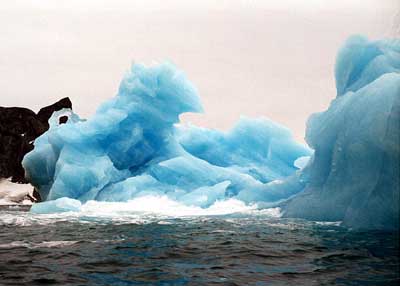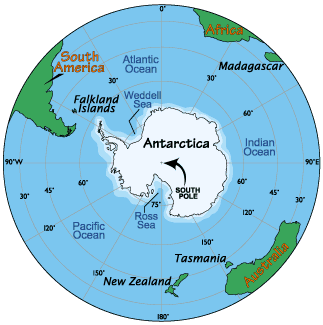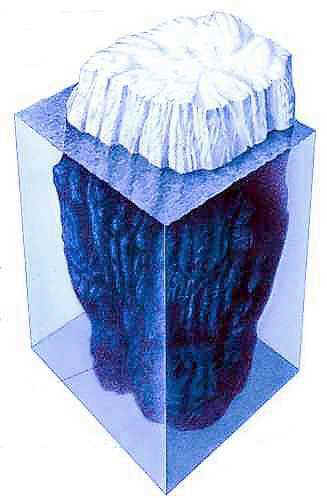|
ICEBERGS |
||
|
HOME SITE INDEX CATAMARAN HULL SOLAR PANELS ELECTRIC MOTORS BATTERIES CREW EXPEDITION SPONSORS |
||
|
During the peak of the last ice age, one-third of the Earth's land surface was covered by thick sheets of ice. Their high albedo reflected a great deal of sunlight out into space, which cooled Earth and allowed the ice sheets to grow. (See our Ice Ages web page.) Ice sheets give birth to icebergs. This process is known as calving. Most bergs are calved from ice sheets off the western coast of Greenland and Antarctica. Icebergs are found in both the Arctic and Antarctic regions. The bergs from these two areas differ, however, in form and size.
Blue iceberg
So what criteria must a chunk of ice meet to officially be called an iceberg? By definition, icebergs are at least seventeen feet proud of the water and fifty feet long. Anything smaller is called a growler or bergy bits. One of the biggest Greenland bergs ever reported by the Coast Guard was 550 feet above the sea. Icebergs in the Arctic regions are formed from mountain glaciers fed by the Greenland ice sheets and are high and narrow, with above-water shapes resembling towers; these are called castle bergs. Large tabular icebergs are found at the ice shelves of Antarctica. One large tabular Antarctic iceberg in 1987 was reported to be 100 miles long, 25 miles wide, and 750 feet thick.
An Iceberg is a floating mass of freshwater ice that has broken from the seaward end of a glacier or a polar ice sheet. Icebergs are typically found in open seas, especially around Greenland and Antarctica.
They form mostly during the spring and summer, when warmer weather increases the rate of calving (separation) of icebergs at the boundaries of the Greenland and Antarctic ice sheets and smaller outlying glaciers. In the Northern Hemisphere, for example, about 10,000 icebergs are produced each year from the West Greenland glaciers, and an average of 375 flow south of Newfoundland into the North Atlantic shipping lanes, where they are a hazard to navigation.
Arctic icebergs vary in size from the size of a large piano, called growlers, to the dimensions of a 10-story building. Icebergs about the size of a small house are called bergy bits. Many icebergs in the Arctic are about 45 meters tall and 180 meters long.
Icebergs of the Antarctic not only are far more abundant but are of enormous dimensions compared with those in the Arctic. Ninety-three percent of the world's mass of icebergs is found surrounding the Antarctic.
Usually 1/8th of an iceberg is above the waterline. That part consists of snow, which is not very compact. The ice in the cold core is very compact (and thus relatively heavy) and keeps 7/8ths of the iceberg under water. The temperature in the core is constant: between -15 and -20 degr. Centigrade. An iceberg that has tumbled over several times, has lost is light snow layers and so the iceberg gets relatively heavier then before (with the snow) and because of the greater compactness, only 1/10th rises above the surface.
Icebergs of Antarctic
Iceberg names are derived from the Antarctic quadrant in which they were originally sighted. The quadrants are divided counter-clockwise in the following manner:
Icebergs come in different colors (but not different flavors). According to Ian Dunlop, they come in white, light blue, or an aqua-green type. White is the standard color and is a result of the ice and snow covering the iceberg. Blue is also from the ice which has compressed all the gas inside so much that the apparent color is blue from light scattering, much like a blue sky. The aqua green is from algae growing in the ice and is only seen when icebergs roll over exposing the previously underwater sections to view.
Icebergs are awesome! They are also dangerous, especially when they journey into shipping lanes. It was just such an iceberg that sank the RMS Titanic in April 1912. The Titanic was not the only ship to ever hit an iceberg. It remains etched in our memory and history because of the great loss of life. The recent Oscar-winning film "Titanic" brought the tragedy to the big screen. Humans touted that they had built an "unsinkable" ship. Nature, however, proved them wrong. The captain ignored the warnings of icebergs and proceeded at an excessive speed with 2224 passengers on board. 1517 people were killed as the ship came to a grinding halt upon striking the iceberg and sank beneath the icy waters. It was this tragedy that led to the formation of the International Ice Patrol now maintained by the U.S. Coast Guard.
US Coast Guard C130 airplane flying over a large iceberg
Recently icebergs have attracted attention as a possible source of fresh water. How do people in Arab countries get fresh water from an iceberg? By lassoing the iceberg for harvest, of course. Towing icebergs is not new. Icebergs are lassoed and towed away from drilling rigs in the North Sea as a safety measure. A hundred years ago ships used to haul small icebergs.
An Alaskan company harvested icebergs floating in Alaskan waters and sold the ice to a firm in Japan as a novelty. One major problem is how to tow the iceberg from the Arctic to the equatorial zone without it melting before reaching its destination. Another problem is how to harvest the fresh water from the iceberg once it arrives.
QUESTIONS AND ANSWERS:
Tip
of the iceberg
Ship and iceberg diagram
|
||
|




